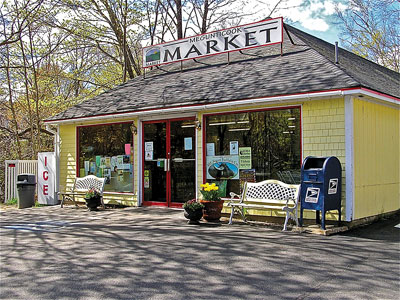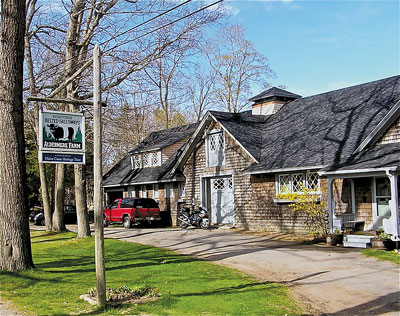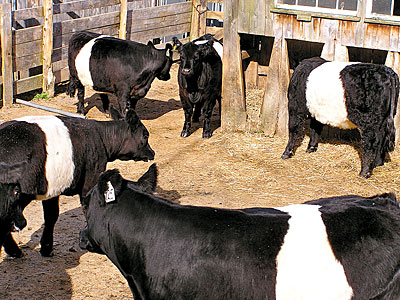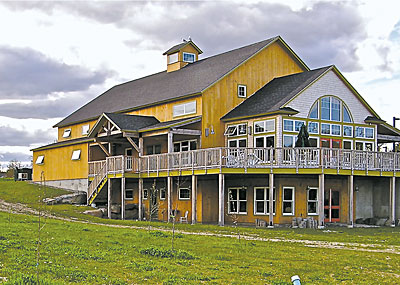 |
| Megunticook Market in Camden offers meat from Caldwell Farms, Terra Optima, Ells Farm and other Maine farmers. English photo. |
 |
| Aldermere Farm in Rockport will be selling its grass-fed beef at the farm this summer. English photo. |
 |
| Belted Galloway cows at Aldermere Farm. English photo. |
Challenges and Opportunities
By Jo Anne Bander
Meat producers and retailers are increasing their numbers in Maine – reflecting the increased demand for local foods. Here’s a glimpse at some of those farmers and vendors.
The Producers
In 2005, Aaron Bell and Carly DelSignore rejuvenated Tide Mill Farm’s dairy operation that had ceased in 1977. They believed that combining an organic operation focused on meat with the dairy operation at the Edmunds farm would provide enough income to support fulltime farming. Chickens, cattle, pigs and turkeys (as well as vegetables) are part of the mix.
Employing rotational grazing in harmony with the 50 dairy cattle they milk, they raise 6,000 chickens per season from purchased day-old chicks using a “chicken tractor” while supplementing with organic grain to get the birds to harvestable weight in 7 to 8 weeks. They also raise 250 to 300 holiday turkeys. They process poultry weekly from May through November.
They sell their certified organic meat and milk products at their seasonal Saturday farm stand; four to six buying clubs; through their CSA; at the Acadia Farmers’ Market on Mt. Desert Island; at stores and restaurants; and through Crown of Maine and Maine Harvest Link. Their year-round buying club serves Lubec, Calais, Machias and Eastport.
Growth means they need to find 30 to 50 certified organic feeder piglets to buy in Maine as well as adequate productive land to raise beef cattle and heifers from their dairy operation. “This is the first year,” says DelSignore, “that I feel that we won’t have enough production to meet demand.”
In Penobscot, Heather and Phil Retberg own their 105-acre Quills End Farm, which they bought in 2004. They use rotational grazing on their 15 open acres and are renovating 30 more acres from woods to pasture to increase grazing for their pigs, beef cattle, lambs, laying hens, goats and dairy animals. Their beef cows are grass-fed and get baleage in winter. Their laying hens are rotationally grazed following the sheep and cattle and get a conventional grain feed including corn and soy. Pigs are raised in the woods and on pasture and get surplus milk and whey from the Retbergs’ homestead cheese making.
In the fall they slaughter 20 pigs, lambs and most of their 10 to 12 beef cattle, turning some lamb into sausage and pigs into smoked hams, bacon and pork cuts to sell directly and through their buying club. In spring they announce offerings for the season, and customers order in advance. The Retbergs grow enough to meet that demand and sell some 90 percent of their beef and pork to customers in bulk. In February they announced availability of their milk, eggs and meat, and products from collaborating farms, to their buying club.
While they sold 1,000 pastured poultry in 2009, they with many others protested state rules that required producers operating under the 1,000-bird exemption to own their own slaughtering equipment and build their own facilities. Rather than raise poultry for meat this season, they will seek grants to build facilities to comply with a new interpretation of raw milk processing. They are also “beginning to build alliances with other farmers and patrons and seek municipal ordinances to protect traditional foodways,” says Heather.
Farther down the Maine coast, those who travel Russell Avenue in Rockport will find an addition to Aldermere Farm and its Belted Galloway cattle this summer: signs announcing on-site sales of its naturally raised beef. This 19th century farm owned by Maine Coast Heritage Trust is a working farm and education center and one of the world’s premier breeders of Belted Galloway cattle. Program assistant Jed Beach says Aldermere is also “becoming a major year-round producer of ‘Beltie’ beef.” Cattle receive no antibiotics or growth hormones; some feed only on Aldermere’s pastures and hay; others graze in summer and are finished with a mix of mostly Maine oats and barley, combined with a beef pellet, which contains conventional corn.
Belted Galloways have grazed at Aldermere since the ‘50s but were used traditionally for breeding. Beach expects beef revenues to exceed hay and breeding stock sales as the farm builds to slaughtering 50 annually by buying “Beltie” calves from other small farms for finishing.
Aldermere now sells individual cuts of steak as well as vacuum-packed family freezer variety beef packs and expects 75 percent direct farm sales in 2010 – with even more market potential.
In Union, Maine, Perry Ells raises 60 ewes on her 63-acres Ellsfarm, bought in 1995. She chose sheep “because of 11 years in Vermont watching the cow dairy industry collapse … and emergence of sheep dairy farming.” She milks the animals in her Maine licensed dairy from April through September.
Ells’ sheep are tied to Maine’s grass and birthing cycle and to market demand as Ells works to bring her product to market at the right weight. Lambing occurs from January to March (107 lambs this season, but the normal average is 125) and grazing from May to November. She also buys and raises some lamb from small farms that use similar husbandry and whose animals have similar genetics; and sells processed lamb from other farmers.
The challenge with grazing is to get some lambs to 120 pounds by Memorial Day at season’s start and to keep a cycle of animals at that weight as Ells delivers five animals a week to year-round markets, necessitating grain supplementation. Her lambs and ewes receive up to 75 percent of their feed from grass, supplemented with custom-mixed grain that has no antibiotics or coccidiostats; it contains conventional soy, corn and barley and a selenium supplement. She also offers a free-choice granular mix.
For slaughter and butchering, Ells uses several shops, each with its own label, and sells her meat under her own farm label as well.
Ells sells primarily to restaurants and markets and has developed a special relationship with Primo’s Melissa Kelly, who features “Ellsfarm lamb” on the menu of her Rockland restaurant. Kelly also helped Ells develop her product and buys as much as Ells can provide.
While Ells previously sold virtually all her milk to Appleton Creamery for cheese and yogurt, that is changing as a new processing room for yogurt and cheese rises on her property. She can generate three times the income from finished products than from raw milk.
In Appleton, Cheryl Denz and Manette Pottle moved to what is now Terra Optima Farm in 1996, as a rural base from which to build Denz’ landscape company. Denz gradually entered the pork business 10 years ago “when my neighbor and I started raising one pig a piece on his property across the road and a calf for beef, which I grazed there also.”
The numbers grew. Her pigs are raised naturally without antibiotics or hormones; start by nursing; move to whey from State of Maine Cheese and Appleton Creamery; and then pasture in the woods. They do get some conventional grain, including corn, barley and soy, especially in winter. Terra Optima can raise as many as 60 at a time, 120 to 140 per year. Their 25 or so head of Hereford beef raised from calves are generally grass-fed only, but in some years may receive conventional beef pellets.
While Denz still does landscaping, she focuses on animals because she “loves interacting with them, the products, tweaking the feed.” She will leave Rockland farmers’ market this season to focus on direct sales, markets and restaurants, from Rockland’s In Good Company to Portland’s Local 188. Demand is sufficient “for a three-fold increase, particularly from restaurants, but it would mean changing the infrastructure, fencing and labor.”
In Windsor, Steve and Helen Hoad and their daughter Rose have lived on Emma’s Family Farm since 1983. Rose’s return from studying sustainable agriculture at Sterling College in Vermont in 2004 propelled them to commercial production. They focus on chickens (laying and meat), ducks, turkeys and geese – with some pigs and beef. Their poultry are pastured and receive conventional grain; their beef animals are grass-fed only; and their pigs are raised on pasture supplemented with local, non-genetically engineered rye, corn and oats. They also raise vegetables using organic practices, according to Rose.
They process pork and beef in the fall and poultry from June to November, with a big spurt of holiday turkeys – 130 in 2009, mostly heritage varieties bred on the farm – selling fresh poultry when available, and frozen through the off-season. They sell eggs year-round, mostly wholesale in winter. Emma’s also raises and markets duck eggs and duck meat, most as pre-orders.
The Hoads sell about 60 percent of their product to individuals at the farm, including spring sales of live chicks, pullets, ducklings and turkeys; they participated in the Lewiston farmers’ market last year; manage their own off-site farm stand from mid-June to mid-October; and sell to six markets. They price their chicken to be accessible through bulk orders and sell to two retailers who take food stamps – Barrels in Waterville and Farmers Fare in Rockport. In 2009, the Hoads processed about 875 chickens at Cooperative Poultry Processors in Monmouth.
Rose is clear that “demand is driven by knowledge, so marketing has to have an educational component.” That includes the next generation: In April they did a farm-to-museum event at the Augusta Children’s Museum.
In Dresden, Marge Kilkelly and Joe Murray focus on raising goats at their Dragonfly Cove Farm, because she had experience raising dairy goats; and meat goat rearing was compatible with their 10 acres of riverside land in both scale and low environmental impact; and they could control production and sales year-round. They feed their animals corn, barley, oats and a seaweed-based mineral supplement, an all-natural product with no hormones, steroids or genetically engineered grain.
Thyme for Goat, founded in 2007, evolved when various producers wanted “to be small scale on their farms, have enough quantity to build a market, assure low stress processing for animals and… do direct sales.” Dragonfly Cove Farm, Springtide Farm and Newaim Farm make up Thyme for Goat, a joint production, branding and marketing company.
Thyme for Goat’s products include frozen meat cuts; fresh sausage sold frozen; and smoked sausage, including pepperoni, salami and summer sausage, now their largest proportion of sales. They expand production by buying older animals from goat milk farmers and some goats from five other small farms with similar principles and feeding practices, creating product from nearly 200 goats in 2009. Their processor is Luce’s Meats in Anson, and their smoker, Smith’s Smokehouse in Monroe.
Luce’s is USDA inspected – critical to Luce’s cross state border sales driven by an early relationship with Heritage Foods USA – and certified humane handling for Whole Foods, which involves a third-party audit.
Arnold Luce quickly became a “mentor” in developing Thyme for Goats products, which continue to evolve through interactions with customers at farmers’ markets – including providing samples and recipes. Many market customers now shop Dragonfly’s retail store, Locavores Lair, and CSA, also an outlet for Dragonfly’s pork, Muscovy duck, turkeys and chicken.
 |
| Farmers Fare in Rockport is devoted to promoting, developing and selling Maine foods. English photo. |
Focused Markets
On Route 90 in Rockport, the large, two-story Farmers Fare is a year-round market devoted to promoting, developing and selling Maine foods. It opened in September 2009 – another response to the local foods movement and one that is helping systematize demand.
Farmers Fare sits on 5 acres of the former Erickson Farm in a specially built New England barn-framed building. Sarah Greer, director of vendor relations and a former owner of Rockport’s Market Basket, has been working for two years with co-owners Terri Thompson-Christie and Peter Christie to find and develop products for this business that “exists essentially to promote locally grown items; to provide healthy food to our local community; and help build that community.”
While knowing the quality of local meat, Greer was concerned about limitations of Maine’s slaughtering and butchering capacity, so Farmers Fare incorporated an on-site butcher shop with equipment and staff to break-down large animals – quarter steer and half pigs, lamb and goat – into retail cuts.
Sourcing almost all Farmers Fare meat in Maine, Greer sees potential to develop additional products from Maine’s excellent raw ingredients. Farmers Fare now smokes pastrami and bacon; and in one 24-hour period made and sold 25 pounds of kielbasa.
Another local foods store, Square Root Natural Foods in Poland, Maine, had a soft February 2010 opening, preceded by Emmy Andersson announcing, “We have prepared a wonderful 1,800-square-foot space in which we will provide the community with produce, milk, eggs, cheese, meat, fish… If you are interested in supplying us, please be in touch!”
Andersson and her husband Zakk Maher met at Vermont’s Green Mountain College, returned to Maher’s home town in 2006, and started Valhalla Fields Farm on family land where they manage a small herd of Highland cattle and a small flock of Icelandic sheep, feeding them certified organic grain, and hay from nonorganic farmers. They also raise pigs on organic grain and composted organic vegetables. In the greenhouses they built, they cultivate tomatoes and culinary herbs organically (but are not certified).
Poland’s lack of a grocery store and the couple’s commitment to local food interested them in developing a market offering healthy foods grown or raised nearby. Conversations with Poland community economic development consultant John Cleveland revealed the space at Poland Crossing Plaza on Route 26. They pieced together financial support from family, North East Bank and Community Concepts Financing Corporation and held the grand opening in March.
Building on vendor relationships from years at the Poland farmers’ market, from Andersson’s work at Axis Natural Foods in Auburn and from selling their own lamb and pork, they are finding enough sustainably grown local meat. While Andersson believes that some people find their prices high, she says, “You get more out of quality food, and by supporting local farmers, you strengthen the community socially and economically.”
In Camden, Lani Temple bought Camden’s Megunticook Market eight years ago and changed “this over 75-year-old community market to one that offers more interesting foods and products.” The key was offering what her customers wanted: more local and prepared foods and more information on preparing food from local products.
Temple began by sourcing beef from Caldwell Farm, then Ells Farm lamb and Terra Optima pork. Megunticook now carries fresh and frozen meat; grinds hamburger from Caldwell beef; and does some butchering; and Temple is looking at water buffalo from the Maine Water Buffalo Company in Appleton.
The “more information there is about our farmers and the more we promote them and their products, the more we’ll grow the movement,” says Temple. Her appearances on Portland’s WCSH6 TV show “207,” where she talks about meats, cooking techniques and local sources, have helped with that growth.
Building Support, Expanding the Movement
The Maine meat movement needs to make state and federal legislation and administration regarding production and processing more appropriate to small farmers, say many producers. Peter Christie, Farmers Fare director of operations, has “started sending people to Augusta whenever we hear of efforts related to meat and poultry.”
Kilkelly, a 16-year veteran of the Maine Legislature and past House and Senate Chair of the Joint Standing Committee on Agriculture, Conservation and Forestry, observes that “our history of agriculture is based on small, diverse farms ringing towns; we are coming back to that model … and public policy needs to be reasonable and supportive. “
Heather Retberg knows that “after our experiences with regulatory agencies this winter, keeping our hands to the plow will not be enough. We must also keep our eyes on the policy horizon. We need to find other farmers and farm patrons and form alliances. We’ll need each other to go forward.”
Mainers are getting the word – and the taste – and buying local meat. To continue to grow and sustain Maine’s small farms and pasture lands, they may need to move beyond voting with their food dollars to making their voices heard in policy arenas.
Resources
About the author: Jo Anne Bander lives and writes in Spruce Head, Maine, and Miami, Florida, and is deeply involved in the sustainable food movement in both states.
